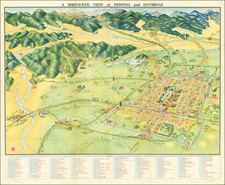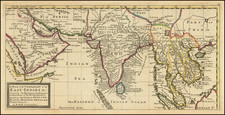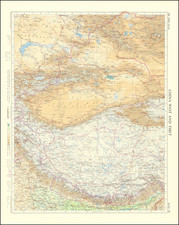An Important Early Dutch Sea-Chart of Australia, the East Indies and Eastern Part of the Indian Ocean.
Finely colored example of the final state of Frederick De Wit's map of Australia, Southeast Asia, the Philippines, etc., first issued in 1675.
The chart is east-oriented and covers the region from the Indian subcontinent to Japan in the east, and to Hollandia Nova, or Australia, in the south. Several ships-three European sailing sloops and one Chinese junk-are braving the waters, which are criss-crossed by rhumb lines.
In the lower left is a spectacularly decorative cartouche embodying the exoticized way that Europeans viewed the Far East. An Asian princess looks out from the window of a pagoda-like structure, a monkey at her side. She gazes out at a man in formal robes who is shaded by an umbrella held by a dark-skinned boy. Behind them a turbaned man smokes a pipe. At his feet are the spoils of the East Indies trade: baskets full of goods, textiles, another pipe (held by a parrot) and tea.
De Wit's chart is based in part on Pieter Goos' chart of 1666. Japan is shown on the Blaeu-Martini model. Martini Martino (1614-1661) was the author of the influential Novus Atlas Sinensis, published by Johannes Blaeu in 1655. Martino was a Jesuit missionary who served in China from 1642-1651, and again from 1658 until his death. There were a spate of new maps of China by Europeans in the mid-seventeenth century thanks to missionary activities. They followed the example set by the world map prepared in China by Matteo Ricci in 1602.
The chart includes much of the coastline of what would come to be Australia. The coastlines of Western Australia are based on early Dutch discoveries, mostly from shipwrecks, and the surveys of Abel Tasman during his two milestone voyages of the early 1640's. A note is on the southwest coast of Australia that explains that this was the area charted by the Leeuwin in 1622. The southernmost discoveries are shown with reference to the voyage of the Gulden Zeepaert, commanded by Frans Thijsz, in 1627. The Gulden Zeepaert was aiming for Batavia but ventured too far south. After finding his bearings, Thijsz explored farther east and named the land he saw Nuytsland in honor of Pieter Nuyts, the highest ranking East India Company (VOC) official on board.
Other noteworthy Dutch discoveries recorded here include the Eendracht, which was blown off course in 1616. It was commanded by Dirk Hartog; both his name and a note about the ship are included on this chart. Finally, G. F. de Wits Landt refers to land explored by the ill-fated Vianen, which was commanded by Gerrit Frederikszoon de Witt. On her first voyage , Vianen was supposed to sail with the VOC fleet for Europe, but an unbalanced load delayed her. When she again set out, the monsoon had set in and drove her so far south that she ran aground in northwest Australia. The crew managed to refloat the vessel and charted as they ran up the coast; they saw aboriginal peoples near present-day Roebourne, possibly the first sighting of indigenous Australians by Europeans in Western Australia. On her second voyage, from Texel for Batavia, Vianen sank in the Sunda Strait.
The first state of the map appeared Frederik De Wit's Atlas de la Navigation (1675), one of the most striking products of Dutch maritime cartography. It was "thoroughly corrected" (Koeman) by Renard in the early eighteenth century and amended again by Ottens in 1745 for their editions of the atlas. Koeman explains, "this continuous revision proves that the atlas was intended for use at sea and not only for the consultation on shore."
The Ottens brothers, Reiner and Joshua, operated a successful printing partnership in the mid-eighteenth century (fl. 1726-1765). They began the venture in 1726, publishing maps and other prints as “R & I Ottens.” They specialized in the reprinting of others’ work, especially Guillaume De L’Isle. In 1750, Reiner died; his soon, also Reiner, took his place, but the firm began listing their works as “Joshua & Reiner Ottens.” The firm lasted until Joshua’s death in 1765. Joshua’s widow, Johanna de Lindt, sold their remaining stock of plates in 1784.










![[ Queensland / Papua New Guinea ] Nouvelle Guinee et Carpentarie](https://storage.googleapis.com/raremaps/img/small/98045.jpg)



![[ Battle of Shanghai - Third Shanghai Expeditionary Force ] Shanghai and District 1936 Edition](https://storage.googleapis.com/raremaps/img/small/100559.jpg)